Wien Bridge Medium Wave Radio Receiver
Testing the Wien Bridge Medium Wave Receiver
Testing the Wien Bridge Medium Wave Receiver
To make the experience fit your profile, pick a username and tell us what interests you.
We found and based on your interests.
Kenneth Kuth's site (http://electronicdesign.com/analog/rediscover-truly-tunable-hall-network) has three interesting OpAmp designs.
The Q multiplier (positive feedback factor) version:
 This circuit would not AC Transfer Analysis properly. So I have to take the Positive Feedback Factor for granted.
This circuit would not AC Transfer Analysis properly. So I have to take the Positive Feedback Factor for granted.
The band-pass version:
 Here Kenneth has differenced the signal and the notch to get a band-pass. In its current form this is tricky without matched transistors for U4.
Here Kenneth has differenced the signal and the notch to get a band-pass. In its current form this is tricky without matched transistors for U4.
And the oscillator version:

It is a little difficult to see but the oscillator version is a schmitt trigger so not really suitable for my application. This style of oscillator seems to be a last resort to get the network oscillating.
The band-pass seems to be the way to go. Here is a transistor concept:
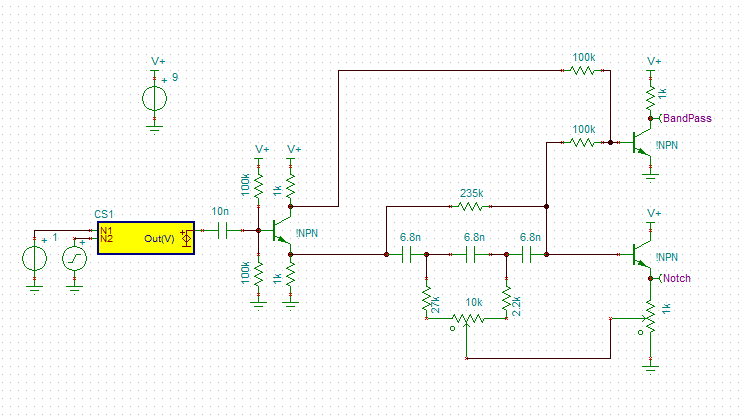
A transistor concept by the way means its lucky to even work!
The above circuit looks a little like a state variable or biquad filter:

The thought of using a MFB filter did cross my mind (R3 changes frequency while gain and bandwidth remains constant):

But the GBW (Gain Band Width) requirement (GBW>Fc*90*Q*Q) will kill it (I don't have a transistor with an Ft of 900 GHz!).
The GBW for a state variable and/or biquad filter is 3*Q (I think).
The biquad looks promising as the frequency is can be tuned by changing one or both RF resistors AND the Bandwidth (not Q) is constant AND the gain is constant. The properties I was trying to extract from the Hall network.
The first two OpAmps in the biquad are easy to convert to a transistor design, the integrator (the third OpAmp) needs some more thought (split power supply perhaps?).
I also found an interesting gyrator circuit:
 And:
And:

But I don't know the GBW requirements.
I designed this transistor biquad filter:
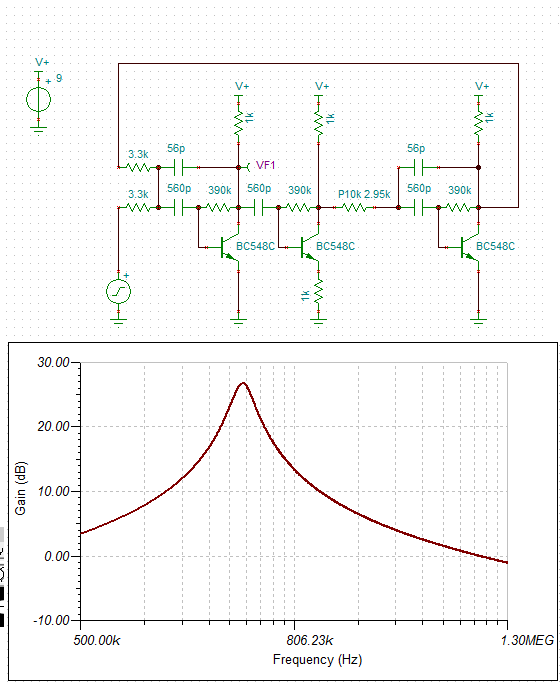
Because my simple transistor makes a pretty bad OpAmp (i.e. input impedance is about 700R), the Q is limited but otherwise it work really well. The Q at 720 kHz is about 20. The simulation suggests some instability (oscillation) at >1.3 MHz for low potentiometer resistor values.
I have had a long play with various transistor configurations but have not made any real progress on the hall bandpass or biquad design. Although the following design has a higher input impedance, the circuit oscillates in the middle of the MW band:
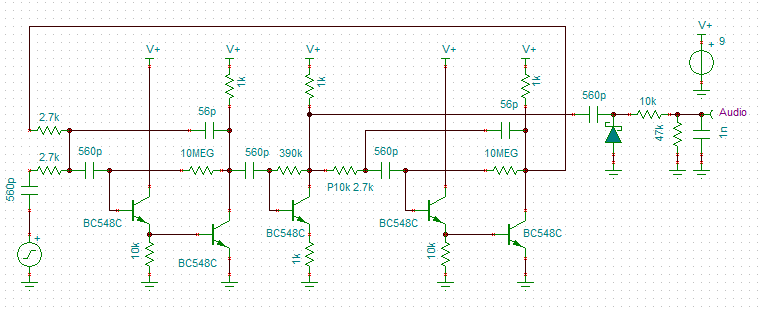
I am stuck! Perhaps I have lost my way.
The Wien Bridge receiver was not an active filter. It was a synchronous detector. Basically a direct conversion receiver with a weak oscillator which the input signal could pull the frequency. Nothing stopping me from designing a direct conversion receiver with no pre-selection LC filter. For example:
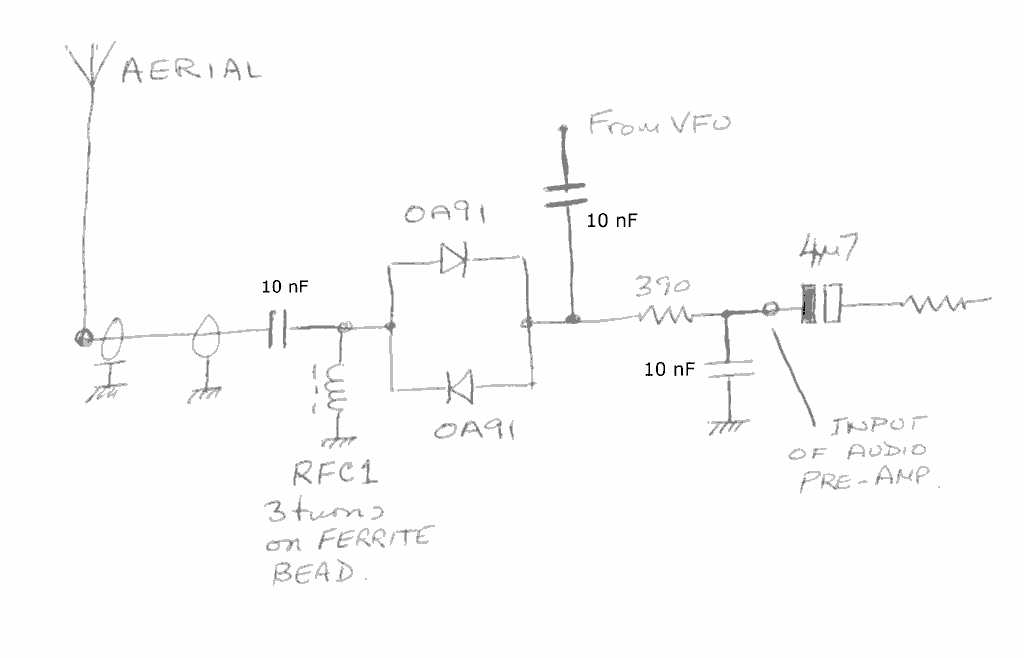
(source: http://www.jbcs.co.za/ham_radio/hamcompdcrx/The_Ham-Comp_Direct_Conversion_Receiver.html).
The VFO could be a TwinT or Wien Bridge oscillator.
Or if you like ICs:

(Source: http://www.amalgamate2000.com/radio-hobbies/radio/ne567_tone_decoder_as_am_fm___de.htm).
I have to have a think about what I am trying to do here!
I found the source of the above diode mixer. It is called the RA2AAE or Polyakov mixer.
It conducts on the peak of the positive and negative swings. A 50% on/off is ideal. Therefore the local oscillator (LO) is half the RF frequency. Obviously the LO power (pp voltage) needs to be correct. The RF choke on the input can be replaced with a ~500R resistor.
So add a Wien Bridge oscillator and a high gain AF amplifier and I have a radio receiver.
Here is another schematic from the Internet:

(source: http://vu3inj.blogspot.com.au/2016/05/40-meter-receiver-7159kc.html).
And the final version of the one above:
 (source: http://vu3inj.blogspot.com.au/2016/05/40-meter-receiver-7159kc.html).
(source: http://vu3inj.blogspot.com.au/2016/05/40-meter-receiver-7159kc.html).
I came across this phase shift RC receiver that is about 90% of what I was looking for:
 (source: http://home.kpn.nl/a.van.waarde/id11.htm).
(source: http://home.kpn.nl/a.van.waarde/id11.htm).
The oscillator is apparently modulated but...
Read more »Well perhaps the first one that basically works.
I decided to try and get a Twin T network to work as a band pass filter. Here I demodulated the signal with a diode envelope detector:
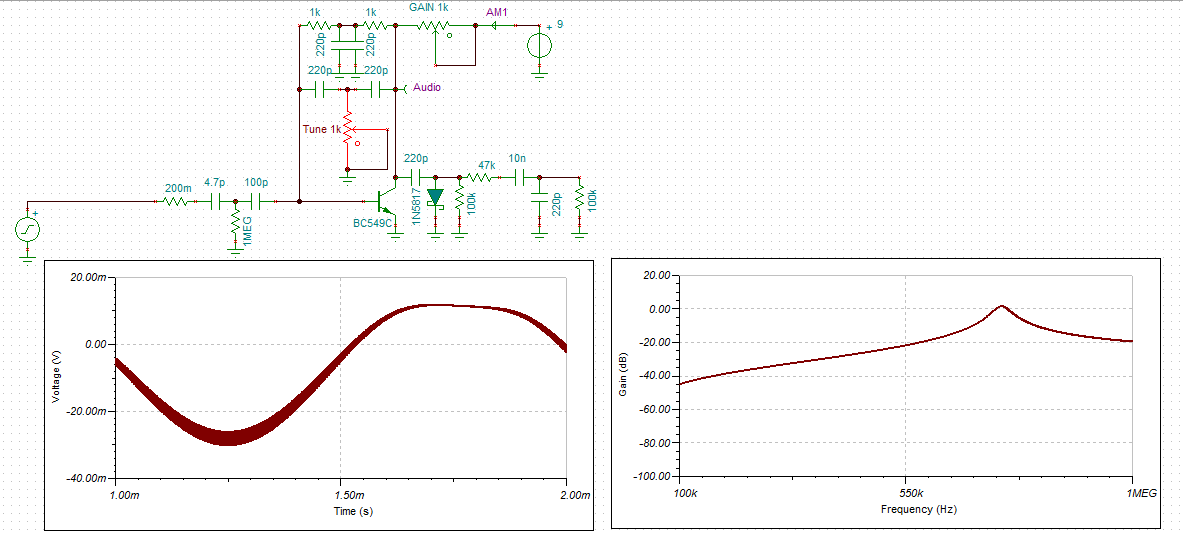
The above graphs are for a 200mv RF signal modulated with a 1k Hz audio tone.
The problems with this circuit are:
But it does work!
I chose a frequency of 720kHz as there is a strong MW/AM station in Perth.
Added a DC/AC bias components and tuned the envelope detector.
This would work in practice (but not well):

Tried adding an emitter resistor so I can bootstrap the network but the circuit will not have it. I think I have to add an additional transistor stage for bootstrapping.
Now the above Twin-T looks great but the network is near its optimal frequency (i.e 723 kHz) and tweaked to be just below the oscillation threshold). Move off this frequency and the Q dies dramatically or the network goes into oscillation (i.e. Gain >0dB and phase angle 180 degrees):
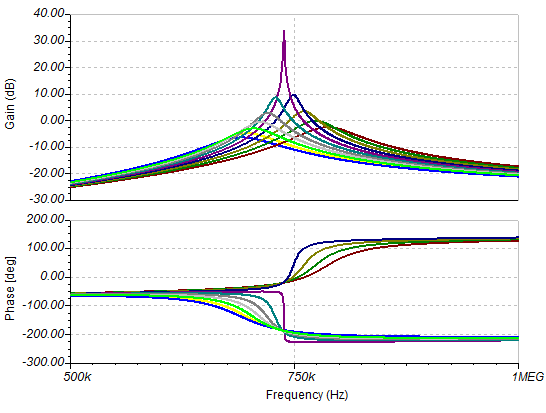
This is why the Hall network is so attractive.
AlanX
Here is the original circuit diagram:
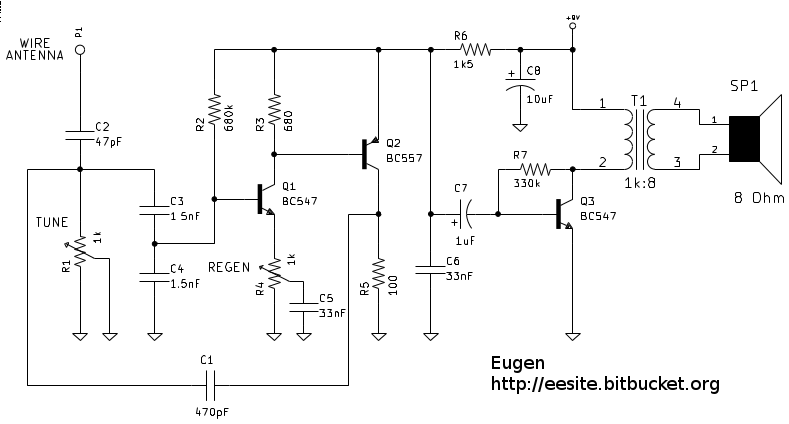
(source: http://eesite.bitbucket.org/html/electronics/wien_regen/wien_regen.html)
I built a simulation of the circuit to confirm that it works, and yes it does.
Here is the frequency analysis for the Regen control setting varied between 20% and 50% (and with the Tune control at minimum (lowest frequency)):

The transient analysis indicates that after the circuit begins to oscillated it builds up slowly with increase in Regen but at some point becomes chaotic, and then goes into audio (pulse) oscillation (squealing).
The Regen setting is sensitive to the input signal.
The DC voltage across the 100 ohm resistor is about 200 mv which limits the oscillation voltage to 10s of mv.
Unlike conventional Wein Bridge oscillators, the single Tune control means the Regen control needs to be readjusted.
The simulation does show audio coming out of the collector of T2 but roughly equal to the modulation level.
Thinking about how this works I assume the oscillator locks onto the input frequency and is basically a synchronous detector (autodyne detection).
If this is the case then it has to oscillated to detect a signal.
Here is the strip-board layout:
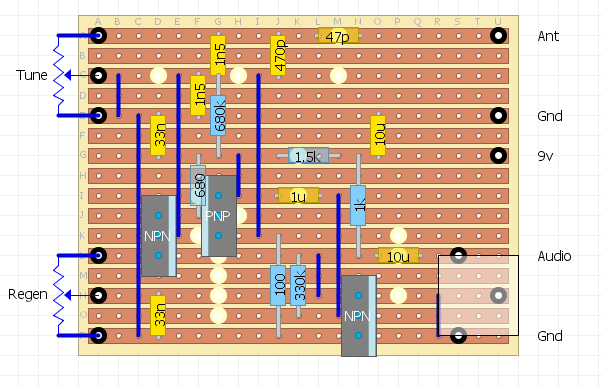
Note I have not used an audio matching transformer.
This is a mistake as the squealing when the circuit goes into audio oscillation is quite loud (in an ear-piece).
With a short aerial (and no audio transformer) and no ground, I could just make out a local station when the receiver is oscillating. The higher the oscillation the better the audio (until it breaks down). No audio without oscillation.
But overall my version of this radio would be considered unusable.
The author's version is quite clever in it's design but I suspect the video is about as good as it can be (remember this is a MW receiver):
I decide to hook up the Wien Bridge receiver to a better antenna.
Well the Wien Bridge liked that!
With a reasonable signal, the circuit has a bit of regenerative/autodyne hysterises.
I will have to investigate this circuit further!
The Wien bridge network could be replaced with another network (e.g a Twin T) that may have better (separated) controls. I found a Hall (notch) network that looks perfect:
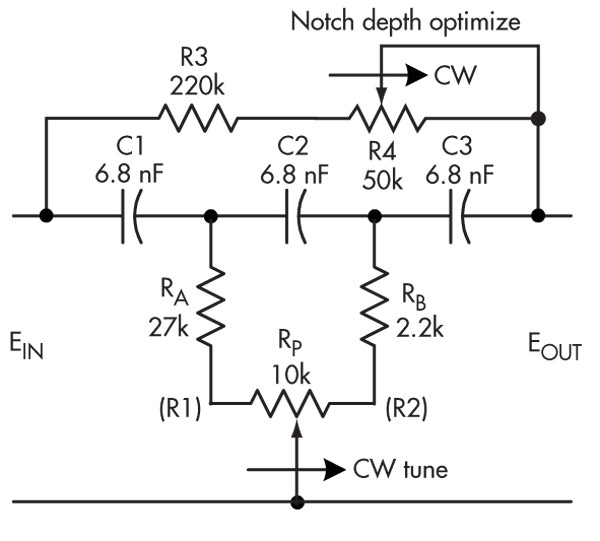
(source: http://electronicdesign.com/analog/rediscover-truly-tunable-hall-network)
Here is a MW tunable (notch) network :
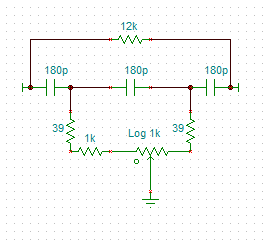
I thought I would check the network input impedance. The simulation says about 2.2k ohm:
Next I have to workout how to turn this into an oscillator. Here is an OpAmp oscillator:
 (source: http://electronicdesign.com/analog/rediscover-truly-tunable-hall-network)
(source: http://electronicdesign.com/analog/rediscover-truly-tunable-hall-network)
AlanX
Create an account to leave a comment. Already have an account? Log In.
Hi Ted,
No, the frequency is pulled by the input signal (to match frequency and phase) so CW and SSB will not work.
This link shows a colpitts autodyne (http://pichub.de/Book/Kap8/Kap8_3.htm):

Basically a very weak oscillator that tracks the input frequency (i.e. the input signal pulls the oscillator).
The first transistor demodulates the signal because of gain differences (6dB per decade of collector current) between the positive and negative oscillation swings.
That is, it is a synchronous detector.
The above circuit is worth having a look at for a direct comparison to the Wein Bridge.
The above circuit would also be a reasonable square-law detector so it would work well in regeneration mode.
Regards AlanX
Hi Ted,
I have written the log. I my case it "just" works.
Basically it works (or at least I think it does) as an autodyne (self oscillation frequency tracking mixer) rather than a regenerative receiver.
I have been through the circuit with a "fine tooth comb" and I can't see how to make it work any better as an autodyne. Practically increasing the oscillator (Regen) range would help.
Perhaps it could work better in pure regeneration mode with a Ge diode detector?
The Author has done a pretty good job, "my hat off to him".
AlanX
If it has to oscillate to work, it sounds like more of a candidate for CW or SSB rx than AM. Maybe tune it up a bit to 160 or 80m?
I can't resist MW receivers of any sort, especially regens. Let us know how it works out!
Become a member to follow this project and never miss any updates
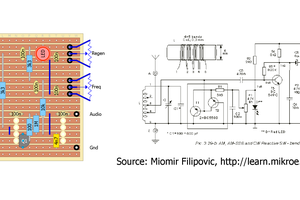
 agp.cooper
agp.cooper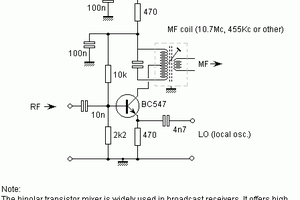
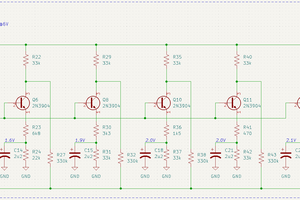
 Manuel Tosone
Manuel Tosone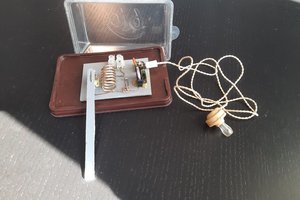
 Andrea Console
Andrea Console
Please pardon my pickingness, but you keep writing "Wein" when it should be "Wien"...
It's the difference (in german) between wine and Vienna :-)